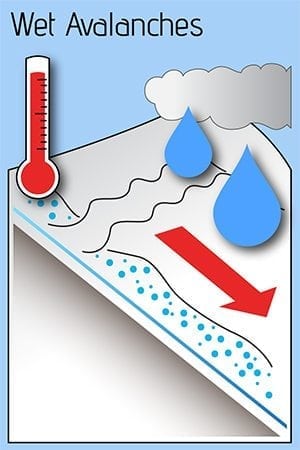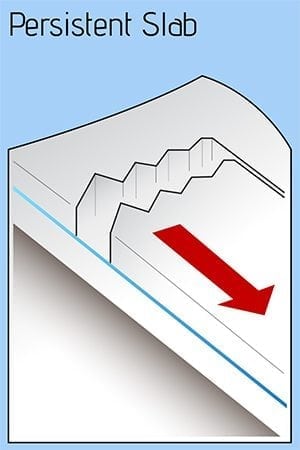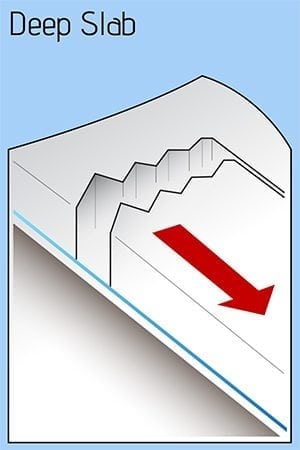Valdez
Above 3,000ftLow
1,500 to 3,000ftLow
Below 1,500ftModerate
Degrees of Avalanche Danger
Avalanche Problems
Problem 1
Colder air and clouds arriving from the north will limit the amount of wet loose activity that occurs to low elevations where high temperatures are expected to go above the freezing mark. Overall temperatures today are expected to be below seasonal averages, which will allow the spring shed process to go on hold today at mid-upper elevations.
Expect to encounter warm snow that is capable of producing wet loose avalanches at low elevations on south and west aspects, especially if the sun is able to break through the clouds today. This avalanche problem is easy to assess, pay attention to the moisture in the surface snow. In areas where the the surface is moist -wet more than 6 inches deep, wet loose activity is possible-likely on steep terrain especially near rocks.
Likelihood:
- Almost Certain
- Very Likely
- Likely
- Possible
- Unlikely
Size:
- Historic
- Very Large
- Large
- Small
Trend
- Increasing
- Steady
- Decreasing
Problem 2
The sensitivity of persistent weak layers beneath the April settled storm snow has been decreasing over the last few days. Lower temperatures, cloud cover and a lack of stress on the upper snowpack today creates a low likelihood scenario for human triggered persistent slab avalanches. Unlikely doesn’t mean impossible. The areas where a persistent slab could be triggered today include upper elevation north facing terrain where settled storm snow depths are greater than 1 foot. Assesment of the interface beneath the settled storm snow is encouraged if traveling in steep and or consequential terrain on shaded upper elevations.
Widespread surface hoar up to 1 cm has been observed and reported at upper elevations. This will be a future weak layer if it is not disturbed by wind prior to the snow that is forecasted this upcoming week.
Likelihood:
- Almost Certain
- Very Likely
- Likely
- Possible
- Unlikely
Size:
- Historic
- Very Large
- Large
- Small
Trend
- Increasing
- Steady
- Decreasing
Problem 3
This may be the last problem on the list and least likely to encounter, but it is the most dangerous one. There have been 2 reports in the last week of cornice fall causing very large persistent slabs to full depth avalanches (see avalanche activity section). Avoiding traveling on or exposing yourself to cornices is highly recommended. Lower temperatures and cloud cover will decrease the possibilty for cornice fall today.
Weak snow exists at the base of our snowpack. On 4/15 our area saw the first deep slab activity occur since late February. This occurred on Meteorite (see avalanche activity section) and was a cornice fall that triggered a series of step down avalanches that eventually stepped down to the ground. This is a clear indication that large triggers can have an affect on depth hoar. Increasing temperatures could produce more significant activity later in the season while our snowpack is undergoing a transition from a winter snowpack to a spring one.
This problem is very difficult to assess due its depth and the fact that signs of instability will likely not be present. You can stack the odds in your favor by avoiding steep terrain that is undergoing rapid changes such as strong solar and avoiding exposure to large triggers such as cornices.

Likelihood:
- Almost Certain
- Very Likely
- Likely
- Possible
- Unlikely
Size:
- Historic
- Very Large
- Large
- Small
Trend
- Increasing
- Steady
- Decreasing
Avalanche Activity
Below is a summary of observed Avalanche activity from the last 7 days. Avalanches that were noted earlier in the season can be viewed by clicking the link below.
If you trigger or observe an avalanche consider leaving a public observation.
4/17- Large natural avalanche reported on the upper Tasnuna just east of “The Wall”. Cornice fall was likely the initial trigger with other sympathetic avalanches occurring as well as full depth step downs. SS-Nc-R2.5-D3

– Skier triggered avalanche reported in the Tasnuna valley “The Hammer” SS-ASu-D2-I down 40 cms on 4/7 buried surface hoar/ NE aspect ~5500′. 5th Skier on slope was caught and partially buried in a crevasse/ skier did not sustain any major injuries.
4/15- A cornice fall produced a series of step down avalanches on Meteorite which resulted in failure at the ground. This intiatied as a cornice fall at 6500′ that triggered an avalanche most likely at the 3/9 interface which then stepped down to a persistent slab around 6100′ NE and stepped down to the ground at 5600′ NE.
SS/HS-NC-D3-O/G 6200′ NE, step down to ground ~5600′ NE

Weather
Check out our updated weather tab! A collection of local weather stations are available for viewing with graphs and tabular data included.
NWS Watches, warnings and advisories
NONE
NWS Point forecast for Thompson Pass
Date Saturday 04/22/23 Sunday 04/23/23 Time (LT) 04 10 16 22 04 10 16 22 04 Cloud Cover OV OV OV OV OV OV OV OV OV Cloud Cover (%) 80 90 90 90 90 85 80 70 75 Temperature 26 30 32 28 22 22 25 18 12 Max/Min Temp 33 21 25 11 Wind Dir W NE NE N N NE NE N NE Wind (mph) 3 6 10 24 23 19 21 24 20 Wind Gust (mph) 40 Precip Prob (%) 0 10 50 70 40 10 20 10 20 Precip Type S S S S S S 12 Hour QPF 0.02 0.10 0.02 0.01 12 Hour Snow 0.0 0.9 0.0 0.0 Snow Level (kft) 1.4 1.5 1.4 0.2 0.0 0.0 0.1 0.0 0.0
Click on link below for Thompson Pass weather history graph:

| Date:
04/22 |
24 hr snow | HN24W* | High temp | Low temp | 72 hour SWE* | April snowfall | Seasonal snowfall | Snowpack Depth |
| Valdez | 0 | 0 | 55 | 31 | 0 | 11 | 248 | 37 |
| Thompson Pass | 0 | 0 | N/O | N/O | 0 | 12 | 438 | N/O |
| 46 mile | 0 | 0 | 52 | 21 | 0 | ~5 | ~116** | 42 |
*HN24W- 24 hour Snow water equivalent in inches
*SWE– Snow water equivalent
**46 mile seasonal snowfall total begins December 1st.
Additional Information
Click on the link below for a running summary of the seasons weather history.
Announcements
The avalanche hazard is moderate below 1500 feet and low above. A decrease in temperatures along with cloud cover will limit the typical spring hazards to low elevations. Human triggered wet loose avalanches are possible on south-west aspects below 1500 feet. In other areas human triggered avalanches are unlikely.
Posted by Gareth Brown 04/22 8:00 am.
For a description of current avalanche problems, weather information, season history and more click the (+ full forecast) button. Avalanche forecasts will be issued Wednesday-Sunday through April 30th.
If you have pictures of recent natural or human triggered avalanches or notice signs of instability such as shooting cracks or collapsing, leave an observation to help improve forecast accuracy.


